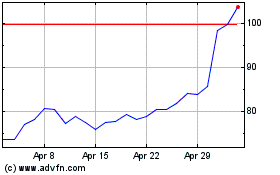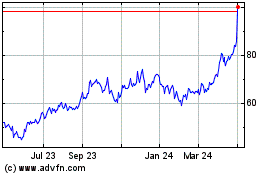Carpenter Announces Strategic Initiatives
September 21 2006 - 8:00AM
Business Wire
Carpenter Technology Corporation (NYSE:CRS) announced today its
strategic initiatives to drive long-term growth. These initiatives
will provide a cornerstone for Carpenter to further enhance Total
Shareholder Return ("TSR"). They include: -- Accelerated growth in
certain core markets, in particular aerospace, medical, and energy,
resulting in a greater mix of higher value materials and products
-- Profitable growth through complementary acquisitions that can be
quickly integrated -- Establishment of a share repurchase program
-- More competitive dividend These actions will be consistent with
Carpenter's financial discipline and its stated financial
objectives. The Company has previously committed to, at a minimum:
-- Sales growth of 5% -- Operating margin of 12% -- Return on Net
Assets of 10% -- Debt-to-Capital of 35% or less -- Economic Profit
"Our success over the last few years has been achieved by focusing
on operational excellence and by investing capital with greater
financial discipline," said Robert J. Torcolini, chairman,
president and chief executive officer. "Through a comprehensive
review process led by Carpenter's Vice Chairman Mike Fitzpatrick,
we have identified significant growth opportunities close to our
core business. Our strong financial position will allow us to grow
profitably, organically and through acquisitions while at the same
time providing our shareholders with increased cash returns through
dividends and share repurchases." Organic Growth At the heart of
the Company's strategy is its plan to build on its core business in
four attractive and fast growing end-use markets: aerospace,
medical, energy, and high value segments of automotive. These
markets require high performance products made to exacting
specifications that cannot be easily substituted. Typically,
Carpenter is one of a few companies worldwide that is able to
supply these technically demanding materials and products. Today,
sales of Carpenter products into these four markets represent
approximately 55 percent, or $875 million, of the Company's fiscal
2006 revenue. As a result of the strategic review process,
Carpenter believes that approximately $500 million of organic
growth opportunities in its highest margin businesses exist in
these markets over the next four years. In the aerospace market,
commercial aircraft build rates are forecast to increase, on
average, 10% annually through 2011. Airbus and Boeing have five
years of production on their order books. These strong order
patterns are coming primarily from Middle Eastern and Asian
airlines and regional and low cost airlines in the United States
and Europe. The major United States and European airlines are also
expected to begin replacing a greater percentage of their fleets
during this period, which would further strengthen demand. Many of
the new, lighter, more fuel efficient aircraft will use
significantly more titanium for their airframes than current models
and will require more of the high temperature superalloys that
Carpenter specializes in for the new generation of high performance
engines. The medical products market is also set for strong growth,
which will generate increasing demand for Carpenter's titanium, CCM
(cobalt / chrome / molybdenum), and specialty stainless products.
These high performance materials are used in medical implants,
surgical instruments, and other critical medical applications. In
the United States and Europe, the population entering its sixties
carries an expectation of additional years of active lifestyles
and, in many cases, a preference for joint replacement rather than
reduced mobility. A better standard of living in Asia is also
generating demand for the latest health care advances. Carpenter
continues to develop new alloys and products to meet the growing
demand of these technology advances. Growth rates in the aerospace
and medical markets are expected to be greater than 10%, on
average, over the next four years. The Company believes this robust
activity will generate increased demand for its highest margin
products, including nickel-based alloys and titanium, in excess of
those growth rates. To capitalize on these opportunities, Carpenter
plans to invest approximately $200 million in capital expenditures
over the next four years, which will include additional premium
melt capacity. Additionally, the company will increase its focus on
key end-use markets and place a greater emphasis on research and
development. Recently, Carpenter modernized two previously idled
electro-slag-remelting ("ESR") furnaces to increase the production
of premium melt products. Carpenter is also currently installing
two additional vacuum arc remelting ("VAR") furnaces that are
expected to be operational by December 2006 and will augment its 17
existing furnaces. The ESR and VAR furnaces are used in the
production of higher margin products for critical end product
applications such as rotating aircraft engine parts, high
performance automotive and truck engine parts, and medical devices.
These investments are in addition to the nearly $500 million of
prior capital spending made between 1997 and 2002. Growth Through
Acquisitions In addition to organic growth, Carpenter will seek to
acquire companies that sell into high growth markets including, but
not limited to, the aerospace, medical, energy and automotive and,
which provide a strong fit with the Company's expertise in high
performance materials. In addition, the Company will seek
opportunities to expand its geographic base. Carpenter's priority
will be acquisitions close to its core businesses and markets that
can make an immediate and meaningful contribution to Carpenter's
operating income. In maintaining Carpenter's financial discipline,
acquired companies will be expected to: -- Generate earnings that
will exceed Carpenter's cost of capital -- Generate earnings that
are accretive to earnings per share in year one Transactions will
be structured in a manner that maintains an investment grade debt
rating. Share Repurchase Program As part of the company's strategy
to enhance TSR, the Board of Directors has authorized a share
repurchase program of up to $250 million of Carpenter's outstanding
common stock. The share repurchase program reaffirms management's
view that Carpenter's stock is an attractive investment based on
its strategic initiatives and expected growth in earnings and cash
flow. The repurchases will occur at such times and at such prices
as the management of the Company determines. The share repurchase
program will be funded with the Company's excess cash after giving
consideration to capital investments, acquisitions and future cash
flows. It is expected that the authorization will be utilized over
the next 12-18 months, subject to market conditions. Dividend
Increase Another element of Carpenter's TSR strategy is its
dividend rate, which was reflected in the 50% increase in the
company's quarterly cash dividend that was announced on August 24,
2006. Carpenter's new annualized dividend is $0.90 per share of
common stock. Torcolini added, "Over the last several years, we
have transformed Carpenter into a company producing and
distributing higher value products. At the same time, we have
lowered our cost structure to further enhance our overall
competitiveness throughout the business cycle. Carpenter expects to
continue generating returns in excess of its cost of capital, and
combined with strong cash flows, is in a position to further reward
shareholders with this increased dividend." The company intends to
maintain a dividend that delivers a return to shareholders
competitive with that of other materials stocks and relevant
indices. Future dividend increases will be made at a measured pace,
consistent with business conditions. There are a number of factors
that the Company will consider in determining the size of future
dividend increases and share repurchases. It is critical that the
Company maintains its strong and flexible financial position in
order to ensure that regardless of the stage of the business cycle,
it will be able to: -- Continue the research, development, and
introduction of new products -- Continue to identify and make
acquisitions that meet its financial criteria -- Make key
investments, capital expenditures and pursue other activities to
achieve its long term profitability. Torcolini concluded,
"Carpenter recently achieved several milestones, including another
record fiscal year and a fourth quarter that surpassed last year's
fourth quarter earnings by more than 40 percent. We are excited
about the growth prospects in our core markets and we are confident
in our ability to capture opportunities which will enable us to
continue to profitably grow our Company and to continue to reward
our shareholders." Carpenter produces and distributes specialty
alloys, including stainless steels, titanium alloys, and
superalloys, and various engineered products. Information about
Carpenter can be found on the Internet at www.cartech.com. Except
for historical information, all other information in this news
release consists of forward-looking statements within the meaning
of the Private Securities Litigation Act of 1995. These
forward-looking statements are subject to risks and uncertainties
that could cause actual results to differ from those projected,
anticipated or implied. The most significant of these uncertainties
are described in Carpenter's filings with the Securities and
Exchange Commission including its annual report on Form 10-K for
the year ended June 30, 2006, and the exhibits attached to those
filings. They include but are not limited to: 1) the cyclical
nature of the specialty materials business and certain end-use
markets, including aerospace, industrial, automotive, consumer,
medical, and energy including power generation, or other influences
on Carpenter's business such as new competitors, the consolidation
of customers, and suppliers or the transfer of manufacturing
capacity from the United States to foreign countries; 2) the
ability of Carpenter to achieve cost savings, productivity
improvements or process changes; 3) the ability to recoup increases
in the cost of energy and raw materials or other factors; 4)
domestic and foreign excess manufacturing capacity for certain
metals; 5) fluctuations in currency exchange rates; 6) the degree
of success of government trade actions; 7) the valuation of the
assets and liabilities in Carpenter's pension trusts and the
accounting for pension plans; 8) possible labor disputes or work
stoppages; 9) the potential that our customers may substitute
alternate materials or adopt different manufacturing practices that
replace or limit the suitability of our products; and 10) the
ability to successfully acquire and integrate acquisitions. Any of
these factors could have an adverse and/or fluctuating effect on
Carpenter's results of operations. The forward-looking statements
in this document are intended to be subject to the safe harbor
protection provided by Section 27A of the Securities Act of 1933,
as amended, and Section 21E of the Securities Exchange Act of 1934,
as amended. Carpenter undertakes no obligation to update or revise
any forward-looking statements.
Carpenter Technology (NYSE:CRS)
Historical Stock Chart
From Jun 2024 to Jul 2024

Carpenter Technology (NYSE:CRS)
Historical Stock Chart
From Jul 2023 to Jul 2024
